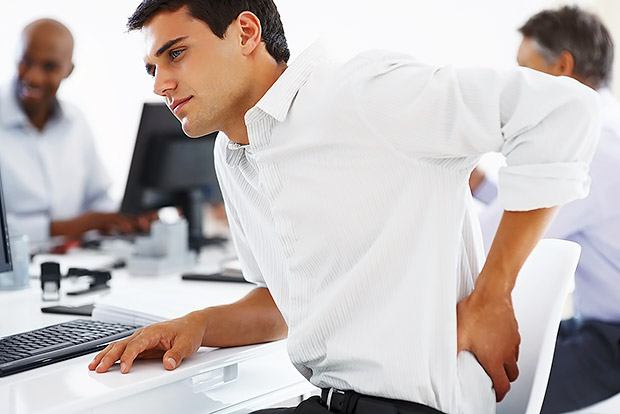
Strengthening the Core
Resistance training that targets the lower back and abdominal muscles helps reduce lower back pain by building a strong core. Common exercises include lower back extensions, bridges, crunches, twists, and leg raises. Performing exercises on a stability ball or with pulley machines requires the use of stabilizing muscles for balance, which also contributes to a strong core and healthy back.
Yoga for Flexibility
Yoga poses increase flexibility and strengthen core muscles. Studies have shown that regular yoga practice can reduce back pain in some people. Consider a gentle or restorative yoga class to get started. These classes have fewer poses and focus on improving flexibility and relaxation.
Correct Computer Workstation
A poorly designed workstation can cause incorrect posture that contributes to lower back pain. The U.S. Department of Labor offers advice on how to set up your computer workstation.
- Adjust your monitor so that the top is at or just below your eye level. Sit so that your head and neck are in line with your torso and keep your shoulders relaxed.
- Your elbows should be held close to your side, bent at 90 to 120 degrees, and supported by armrests if possible.
- Adjust your seat height so that your wrists and hands are in line with your forearms when typing.
- Choose a desk chair with lumbar support or roll up a towel and place it between your lower back and the back of the chair.
- Keep your feet flat on the floor and consider using a foot riser so that your knees are at hip height.
Safe Lifting
Lifting heavy objects is a major cause of lower back pain, but using proper form can help reduce your risk of injury. Follow these tips for lifting with your knees and not with your back.
- Stand close to the object with feet about hip-distance apart.
- Bend at the knees and the waist and grasp the object. You should be in a squatting position. Avoid bending only at the waist.
- Avoid twisting or turning the body when you are carrying the load. Your feet should face the direction you plan to move with the object before you lift it.
- Return the object using the same process. Bend your knees and lower to the ground. Try propping the object on your knee as you slowly slide it to the floor.
- Always test the weight of an object before trying to lift it. If the object is too heavy, ask for help or use a dolly or cart.
Supportive Sleep Position
Your sleeping position can reduce the risk of lower back pain. The Mayo Clinic recommends using pillows to make sleep comfortable and safe for your back.
- On your side - Pull your knees up to hip level and place a pillow between your knees. The pillow supports the top leg and prevents spine rotation.
- On your back - Keep the natural curve of your spine by placing a pillow under the back of your knees and a small, rolled towel under your lower back.
- On your stomach - Place the pillow under your hips and also rest your head on a pillow if it does not cause neck strain.
Check with your healthcare provider when you experience lower back pain. When choosing treatment and selecting the best steps to prevent future pain, it’s important to rule out serious causes such as slipped discs.
Sources
- National Institute of Neurological Disorders and Stroke - Low Back Pain Fact Sheet
- The Mayo Clinic - Sleeping Positions that Reduce Lower Back Pain
- U.S. Department of Labor - Computer Workstations
- Harvard Medical School - Yoga can help ease low back pain
- UC Berkeley University Health Services - Safe Lifting Tips
- National Safety Council - Tips for Safe Lifting Techniques



 4 Tips for Healthy Office Meetings
4 Tips for Healthy Office Meetings
 11 Healthy Distractions to Help You Stop Snacking
11 Healthy Distractions to Help You Stop Snacking
 6 Tips for Hosting a Healthy Party
6 Tips for Hosting a Healthy Party
 10 Ways to Cut 100 Calories (or more!)
10 Ways to Cut 100 Calories (or more!)
 8 Ways to Celebrate Your Weight Loss
8 Ways to Celebrate Your Weight Loss
 Healthy Changes You Can Make in Minutes
Healthy Changes You Can Make in Minutes
 6 Grocery Shopping Mistakes
6 Grocery Shopping Mistakes
 Tips to Prevent High Blood Pressure
Tips to Prevent High Blood Pressure

 Pinterest
Pinterest RSS Feed
RSS Feed